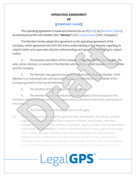Understanding the Intricacies of a Contribution Agreement for Cash or Assets
Understanding contractual agreements is never simple. So, let's break it down. As an entrepreneur, having a handle on these agreements is like having...
6 min read
LegalGPS : July 25, 2024 at 1:05 PM
Navigating legal matters can often be daunting, especially when it involves something as important as a withdrawal agreement. If you're a business owner or entrepreneur who needs assistance in understanding withdrawal agreements, this guide is for you. We aim to provide you with clear, concise, and approachable information to break down this complex legal topic. Let's dive in and learn about withdrawal agreements, why they're important, and how to write one effectively.

Legal GPS templates are drafted by top startup attorneys and fully customizable.
Withdrawal agreements are crucial legal documents outlining the terms and conditions under which a party withdraws from a contract, organization, or union. They play an essential role in managing the repercussions of parting ways and often include topics like financial settlements, obligations, and rights.
In this guide, we will explore what a withdrawal agreement is, its history, who can benefit from it, and how to write one effectively. We'll cover all the vital aspects, making it accessible and actionable for you as a business owner.

A withdrawal agreement is a legal document in which one or more parties outline the terms and conditions under which they will withdraw from a contract, organization, or union. This agreement contains detailed information about the rights, benefits, and obligations of all involved parties during and after the withdrawal process.
One of the most prominent examples of a withdrawal agreement in recent history is the UK's Brexit. Britain voted to exit the European Union (EU) in 2016, and the UK government officially triggered Article 50 of the Treaty on European Union (TEU) in March 2017. This event began the process to negotiate and prepare the Withdrawal Agreement between the UK and the EU.
The Withdrawal Agreement outlined essential aspects of the Brexit process, including the UK's financial settlement with the EU, the protection of EU citizens' rights residing in the UK, and the necessary arrangements for the Irish border.
While the Brexit Withdrawal Agreement is an example of agreements between countries, they can also be applicable to various parties on a smaller scale like:
Business Partners: When a business partner decides to leave, a withdrawal agreement can help split ownership, shares, and resolve any outstanding legal or financial responsibilities.
Investors and Shareholders: If an investor or shareholder decides to exit an investment, a withdrawal agreement can be used to outline the terms, conditions, and processes for withdrawal.
Contractual Agreements: Withdrawal agreements are crucial for managing the exit and transition process from contractual business arrangements or joint ventures.
Memberships: Organizations, clubs, or associations can also employ withdrawal agreements when members decide to leave, ensuring a smooth transition and addressing matters like fees and confidential information.
A well-crafted withdrawal agreement helps provide certainty and clarity when it comes to the departure of a party from an agreement, organization, or union. Here are some key reasons why withdrawal agreements are essential:
Eases the Transition Process: Withdrawal agreements minimize the risk of disagreements or misunderstandings during the exit process, resulting in a smoother transition for both parties.
Protects Rights and Interests: A withdrawal agreement outlines each party's rights and obligations, ensuring that everyone's interests are protected during and after the withdrawal process.
Addresses Financial Matters: Withdrawal agreements can help manage financial settlements and obligations, such as outstanding debts and investments, ensuring that all parties understand their responsibilities.
Defines Legal Requirements: Withdrawing from an agreement, organization, or union can entail specific legal requirements that need to be addressed. A withdrawal agreement can help detail these requirements, ensuring that all parties are compliant.

Protect your business with our complete legal subscription service, designed by top startup attorneys.
To write an effective withdrawal agreement, it's essential to include the following key components:
Effective Date: Set the date when the withdrawal agreement will take effect.
Parties Involved: Clearly define the parties involved in the agreement, including their contact information.
Background and Reason for Withdrawal: Outline the context and reasons for the withdrawal, establishing a clear understanding of the circumstances.
Financial Settlements: Specify how financial matters will be handled during the withdrawal process, whether it be asset distribution, outstanding debts, or trade commitments.
Rights and Obligations: Detail the rights and obligations of each party during and after the withdrawal process.
Dispute Resolution: Establish a mechanism for resolving disputes that could arise during the withdrawal process.
Confidentiality Clause: Address the handling of confidential information to protect each party's interests.
Modification and Termination: Specify under what conditions the withdrawal agreement may be modified or terminated.
Governing Law: Indicate the legal jurisdiction or country whose laws will govern the agreement.
Signatures: The parties must sign and date the withdrawal agreement.
Here's a step-by-step guide on how to create a comprehensive and actionable agreement.
This is the first item in the document, indicating when the agreement goes into effect. Include the exact date (day, month, year). This sets the timeline for all subsequent events and responsibilities.
**Effective Date:** [Enter the day, month, and year]Clearly define who is involved. Include their full names and contact information to avoid any confusion.
**Party 1:** **Full Name:** [Enter full name of the first party] **Contact Details:** [Enter contact details of the first party] **Party 2:** **Full Name:** [Enter full name of the second party] **Contact Details:** [Enter contact details of the second party]State why the withdrawal is happening. This context ensures all parties understand the situation and provides a basis for the terms that follow.
**Background and Reason for Withdrawal:** [Enter the specific reason for withdrawal]Detail the financial responsibilities of each party, including any assets, outstanding payments, or investments. List each element separately for clarity and ensure each party's financial duties are outlined.
**Financial Settlement:** **Asset Division:** - Party 1: [Detail how assets will be divided] - Party 2: [Detail how assets will be divided] **Outstanding Payments:** - Party 1: [Detail the remaining payments] - Party 2: [Detail the remaining payments] **Investments:** - Party 1: [Detail the investment responsibilities] - Party 2: [Detail the investment responsibilities] Outline the rights, obligations, and responsibilities of each party. This part should be clearly explained and agreed upon by all parties to avoid future disputes.
**Rights and Obligations:** - Party 1: [Enter the specific rights and obligations of the first party] - Party 2: [Enter the specific rights and obligations of the second party]It's essential to anticipate potential disagreements and define an agreed-upon method for resolving disputes. You might consider mediation or arbitration.
**Dispute Resolution Method:** [Enter the chosen method for dispute resolution]Address how confidential information will be handled during and after the withdrawal process. This protects each party’s interests and prevents misuse of information.
**Confidentiality Clause:** [List down the terms for handling confidential information]Specify the conditions under which the agreement can be changed or ended. Try to cover as many scenarios as possible to avoid future misunderstandings.
**Modification Conditions:** [Define under what circumstances the agreement can be updated or modified] **Termination Conditions:** [Define under what circumstances the agreement can be terminated]State which country's or state's laws will apply in governing the agreement. This is particularly important if the parties are based in different jurisdictions.
**Governing Law:** [Enter the jurisdiction that will govern the agreement]The withdrawal agreement should be signed and dated by all parties involved. This official seals the deal and makes the agreement legally binding.
**Signatures:** **Party 1:** Signature: ____________ Date: ____________ **Party 2:** Signature: ____________ Date: ____________
Get Your Withdrawal Agreement Template
with a Legal GPS Subscription
When writing a withdrawal agreement, you may encounter some challenges:
Understanding Legal Requirements: A withdrawal process can involve complex legal requirements that both parties must adhere to. It's crucial to research and understand these rules to ensure your withdrawal agreement is compliant. Alternatively, consider hiring a legal expert to guide you through the process.
Balancing Interests: Withdrawal agreements must ensure that both parties' interests are protected. Strive for fair and balanced terms that are acceptable to everyone involved.
Managing Complex Financial Matters: Financial settlements can be challenging when dealing with assets, outstanding debts, or investment terms. It's essential to define clear guidelines for the management and distribution of financial matters in your agreement.
Addressing Potential Disputes: It's vital to include provisions to handle disputes in your withdrawal agreement. Consider a dispute resolution mechanism, such as mediation or arbitration, to facilitate conflict resolution.
A well-crafted withdrawal agreement is a powerful tool that facilitates a smooth and efficient exit process. By understanding its importance and the key components to include in the document, you can create a solid foundation for any withdrawal situation. Always keep in mind that each withdrawal agreement should be tailored to the specific needs of the parties involved. We hope this guide has been helpful and insightful in your quest for understanding withdrawal agreements.
Ready to write a withdrawal agreement? Our professionally designed contract template can help you through the process. Access the contract template here. Save time, protect your interests, and ensure a smooth withdrawal with our easy-to-use template.
Get Legal GPS's Withdrawal Agreement Template Now

Protect your business with our complete legal subscription service, designed by top startup attorneys.

Understanding contractual agreements is never simple. So, let's break it down. As an entrepreneur, having a handle on these agreements is like having...

When you’re talking about property leasing, it’s important to understand that there are a lot of terms and concepts that you may have never heard...

As an entrepreneur, you may find yourself partnering with other businesses or independent professionals to boost your marketing reach. If you're in...